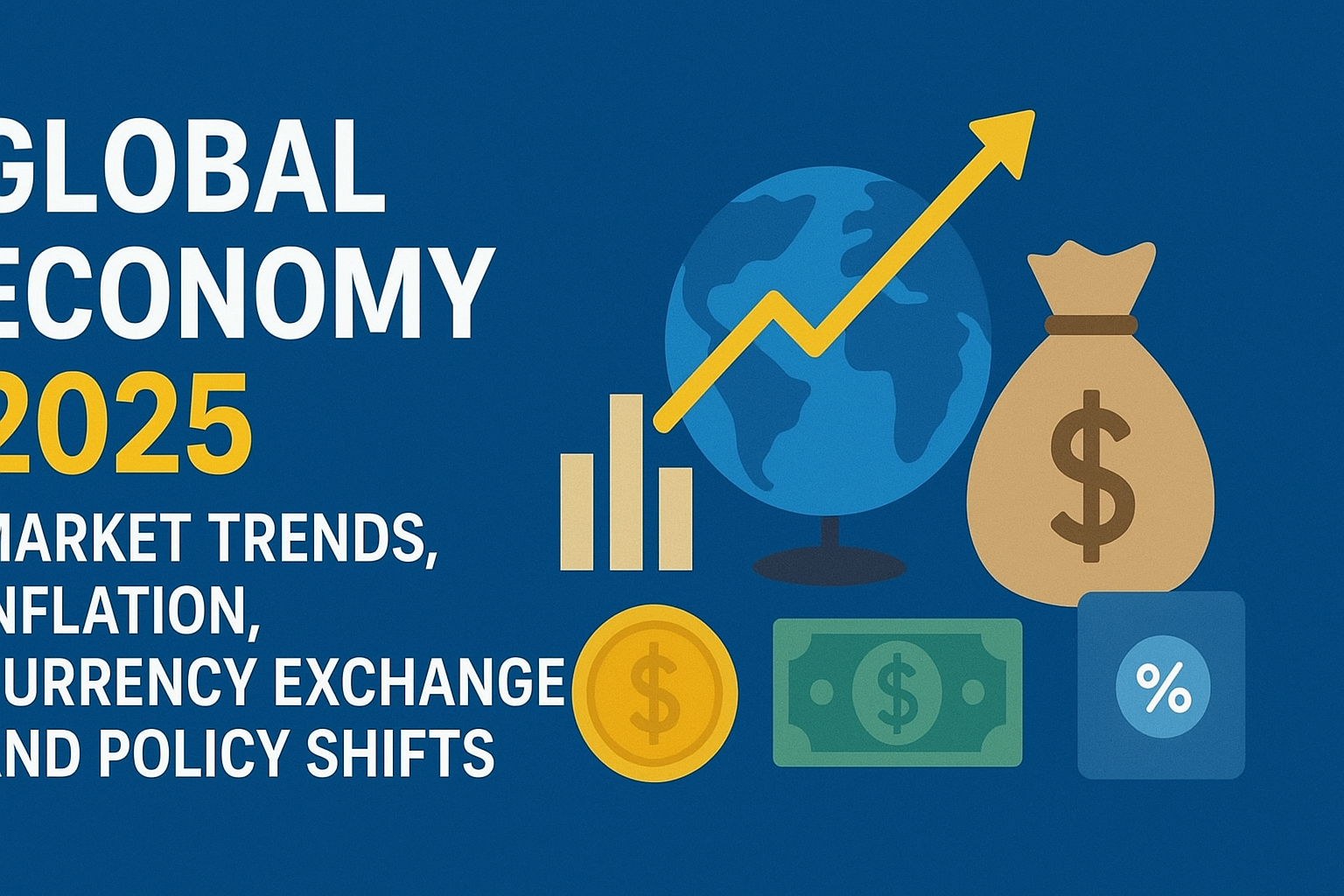The global economy in 2025 is navigating through rapid changes shaped by inflationary pressures, technological advancements, geopolitical tensions, and evolving government policies. From stock market movements to currency fluctuations, individuals, businesses, and investors are closely monitoring global economic indicators to make informed decisions.
This article provides a detailed overview of market trends, inflation updates, currency exchange, and major policy shifts influencing the world economy today.
1. Global Market Trends in 2025
Global financial markets are experiencing both volatility and opportunity. Stock indices in the US, Europe, and Asia have shown resilience, despite challenges like rising interest rates and global supply chain disruptions.
Key Market Trends:
- Tech Dominance: Technology, AI, and renewable energy companies are leading stock market growth.
- Emerging Markets Growth: Countries like India, Brazil, and Vietnam are seeing increased foreign investments.
- Green Economy: Climate-focused companies and ESG (Environmental, Social, Governance) funds are gaining traction.
- Volatile Commodities: Oil and natural gas prices remain unpredictable due to geopolitical tensions.
- Investor Takeaway: Diversification across markets and sectors is the best way to balance risks and returns in 2025.
2. Inflation Updates – A Persistent Challenge
Inflation continues to be one of the most pressing issues for economies worldwide. While some nations have managed to reduce inflation through monetary tightening, others still struggle with high consumer prices.
Global Inflation Snapshot (2025):
- United States: Inflation has eased to around 3–3.5%, but housing and healthcare costs remain high.
- Eurozone: Prices have stabilized, though energy inflation is a concern.
- India: Inflation is around 5–6%, mainly driven by food and fuel prices.
- Developing Nations: Some countries face double-digit inflation due to weak currencies and rising imports.
- Impact on Citizens: Higher inflation erodes purchasing power, making essentials like food, housing, and healthcare costlier. Governments are responding with subsidies, monetary tightening, and structural reforms.
3. Currency Exchange – Volatility in Global Trade
Currency exchange rates play a critical role in international trade, investment, and tourism. In 2025, major currencies are experiencing fluctuations due to US monetary policy, global demand, and geopolitical risks.
Currency Trends in 2025:
- US Dollar (USD): Strong against many currencies due to high interest rates, but gradually stabilizing.
- Euro (EUR): Recovering as European markets show resilience.
- Indian Rupee (INR): Stable at ₹82–84 per USD, supported by strong foreign reserves and IT exports.
- Chinese Yuan (CNY): Facing pressure due to slower domestic growth.
- Cryptocurrencies: Bitcoin and Ethereum remain volatile but continue to attract investors as alternative assets.
- Investor Note: Businesses engaged in imports and exports must use hedging strategies to protect against sudden currency fluctuations.
4. Economic Policies Shaping 2025
Government policies are a driving force behind global economic performance. From monetary tightening to trade agreements, policy decisions have far-reaching consequences.
Key Policy Developments in 2025:
- United States: The Federal Reserve has adopted a cautious stance, keeping interest rates moderately high to control inflation.
- European Union: Focus on green energy policies, carbon neutrality, and reducing dependence on fossil fuels.
- India: Continued reforms in taxation (GST updates), digital payments expansion, and foreign investment policies.
- China: Balancing growth with debt control and boosting domestic consumption.
- Global Initiatives: G20 countries are working on frameworks for cryptocurrency regulation and digital trade policies.
- Impact: Pro-growth policies in emerging markets are attracting global investors, while developed nations focus more on stability and sustainability.
5. How Inflation and Currency Trends Affect Everyday Life
- Rising Living Costs: Households are adjusting budgets as food and housing prices remain high.
- Borrowing Costs: Higher interest rates make personal loans, mortgages, and business loans more expensive.
- Travel & Tourism: Stronger currencies like the USD make international travel costlier for developing nations.
- Investment Choices: People are shifting toward inflation-protected securities, gold, and diversified global funds.
6. The Future of the Global Economy
- Looking ahead, the global economy in 2025 will depend on:
- Technological Innovation: AI, blockchain, and renewable energy will drive productivity.
- Geopolitical Stability: Conflicts and trade wars could disrupt growth.
- Climate Action: Green finance and carbon neutrality goals will reshape industries.
- Digital Currencies: Wider adoption of central bank digital currencies (CBDCs) may transform global payments.
- Experts believe that while short-term volatility is inevitable, long-term growth opportunities exist in emerging markets, technology sectors, and green industries.
Final Thoughts
The global economy in 2025 is a mix of challenges and opportunities. Market trends highlight technology and green growth, while inflation continues to test resilience. Currency exchange remains volatile, but proactive policies by governments and international organizations are helping stabilize trade and investments.
Also Read : किराएदारों के लिए खुशखबरी! Home Rent Rules 2025 में आ गए हैं ये नए नियम
For individuals and businesses, the best approach is to stay informed, diversify investments, and adapt to evolving policies. By doing so, they can navigate uncertainty and secure financial stability in a rapidly changing world.






